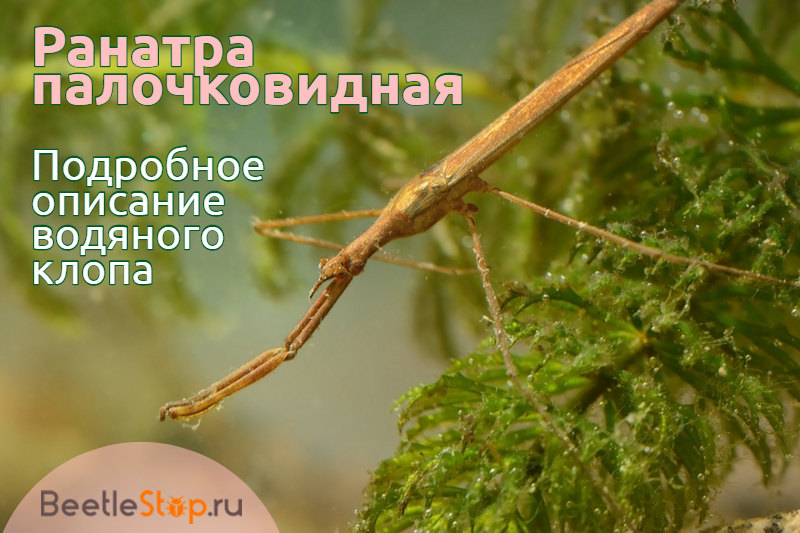Ranatra rods - indicator of water pollution
Among water bugs, the family of water scorpions is characterized by the presence of grasping limbs and a breathing tube located at the end of the body. The true diversity of species can be found in the tropics, the two genera Ranatra and Nepa have chosen the Northern Hemisphere. Only 3 species of the genus Ranatra are found in the Palearctic, one of them is rod-shaped. Representatives of this group have an elongated body that looks like a mantis. Ranatralinearis is Europe's largest bug.

Morphological description of the species
The species of aquatic bugs of the Ranatralinearis ranatra belongs to the aquatic scorpion family. Another name for the insect is the water stick. The body is narrow, cylindrical in shape. The abdomen ends with a 20 mm long breathing tube. The body size of the female is 35-44 mm, the males are smaller - 33-35 mm. Coloring yellowish-gray, upper abdomen red, yellow sides. The head is small, most of it is occupied by large faceted eyes in the shape of a ball. There are short antennae of three segments. The proboscis is free, piercing and sucking, moving away from the front edge of the head. The strong organ is directed forward and slightly downward.
Ranatra refers to a squad of half-winged, its front wings are half leathery. They completely cover the abdomen. The hind wings are wide, transparent, milky white. Fold only along the body. The wings are well developed, insects make confident and long flights. Prothorax elongated, slightly narrowed in the middle.
The odorous bugs of the bug are located in the posterior thorax; the secret comes out between the coxae of the hind limbs. A characteristic feature of the species - the front legs transformed into grasping limbs. They lost their thickened thighs, claws on the paw, lower leg decreased significantly. Middle and hind legs walking, used for movement on land.
Information. Water stick is the only species of the genus Ranatra found in the European part of Russia.
Parasites
The body of the bug is covered with a solid cuticle. A robust casing is necessary to protect against parasitic water mites. Significantly fewer tick larvae were observed on the ranatra than on other aquatic semi-rigid winged ones. Parasites concentrate on the lower body, at the base of the limbs.
The breath of the water stick
The breathing tube or siphon consists of two halves widened at the base. They form an air channel lined with hairs from the inside. Water does not get into it. The process of breathing is as follows: holding the stalk of a plant, the ranatra hangs upside down, protrudes the tube from the water. Through the grooves, the air goes to the spiracles. Representatives of water scorpions have 8 pairs of abdominal spiracles and 2 pairs of thoracic spiracles. Air passes through the tube to the eighth pair of spiracles. According to the trachea system, it passes into the first pair and accumulates under the elytra.
Habitat
Ranatra is rod-shaped distributed throughout Europe, except for the northern regions. This is the largest water bug in this area. Insects are found in North Africa, Western and Central Asia, and Kazakhstan. The species lives in the European part of Russia, in the south of Siberia, in Transcaucasia.
Lifestyle
Ranatra rod-shaped settles in stagnant and low-current reservoirs. The insect is inactive in water. He spends most of his time frozen among aquatic vegetation. Due to the structure of the body and the protective color, the bug resembles a thin twig. Water stick sticks poorly, slowly fingering, clutching aquatic plants. It can’t catch prey, it catches invertebrates that are nearby. Adults attack tadpoles and fish fry. The predator rushes to any mobile prey within reach. Even when fed up, the stick continues to hunt and kill.
Information. Due to the pollution of water bodies by oil products, the number of water bugs is reduced. An oily film on the surface prevents insects from breathing through the tube. The limiting factors include the elimination of shallow water during landscaping.
Breeding
Adult individuals are active from July to October, and remain in the water for wintering. Prefer places with a sandy bottom, kept in shallow water. In October, they migrate in search of a more suitable place. In rare cases, insects spend the winter on land.
The breeding season begins in late spring. During mating, the male has to interrupt the act in order to breathe air. His breathing tube is located next to the genital capsule. The duct must be moved apart to give birth. The female lays eggs in the tissues of plants floating on the surface of the reservoir. The eggs are large, oval, at the end there are two filiform processes for air intake. Fertility of a female is 30 eggs.
After 2-3 weeks, larvae emerge from the eggs. At the first age they are 7 mm long, painted yellow, darken after molting. In the process of development, the larva passes through five ages. The maximum body size is 35-36 mm. Outwardly, the offspring is similar to adult bugs, but does not have wings and a breathing tube. Before molting, the larva clings tightly to the plant with its paws. The gap of the old skin runs longitudinally through the back. The insect slowly crawls out through the gap, leaving a tight cover. During breathing, the larva rises to the surface of the water and touches it with the middle and hind limbs. They do not have a full siphon, only a small process.
Information. Among water scorpions there are cases of cannibalism. An adult ranatra can eat a larva of its own species.
Water stick - an insect with incomplete transformation. Larvae do not transform into pupae. The entire development cycle from an egg to an adult, a water bug takes 3 months. The enemy of the rod-shaped ranatra is chalcide, which lays its eggs on the offspring of the bug.

